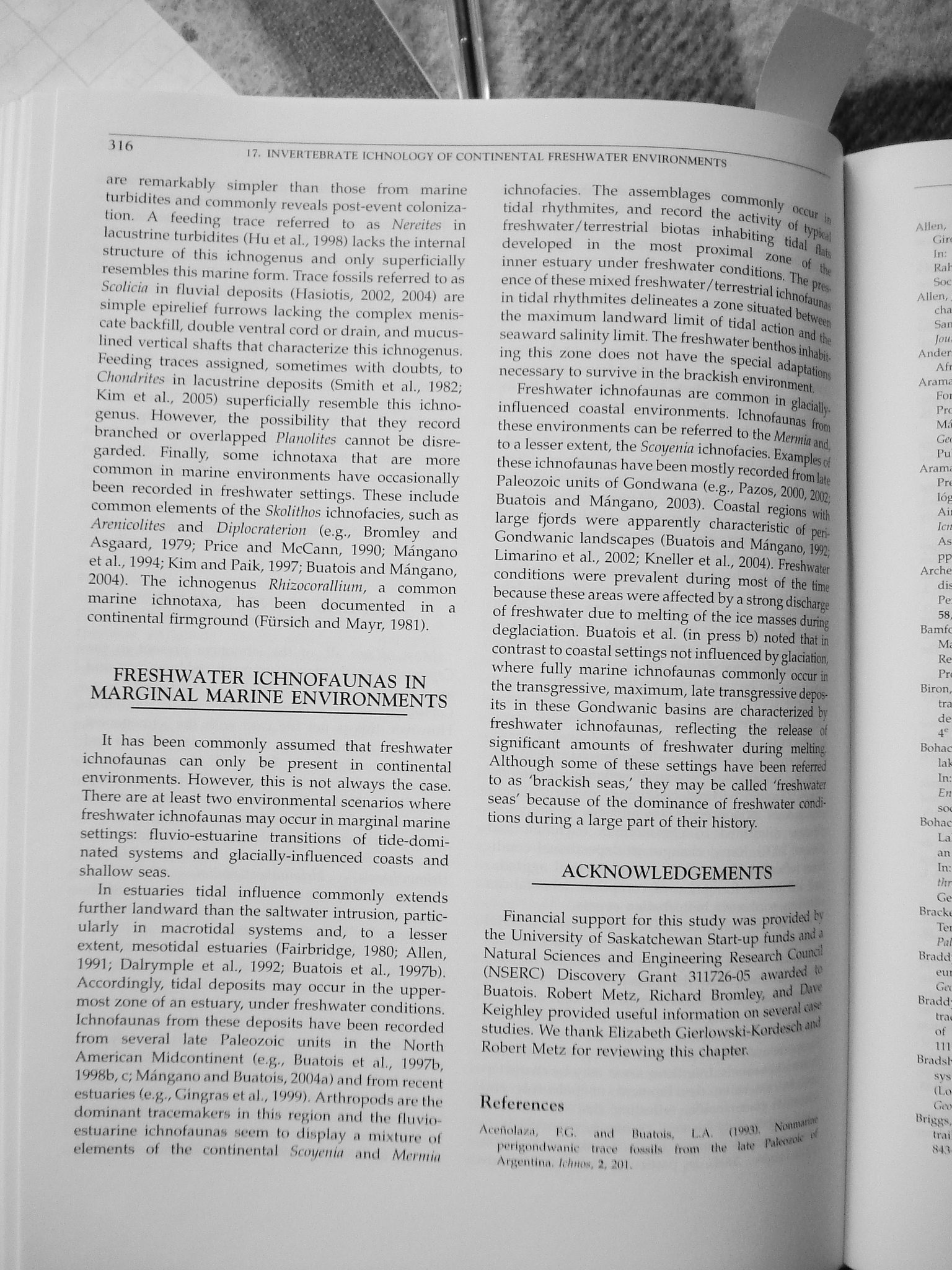dsc08836 (2)

i16 17. INVERTEBRATE ICHNOLOGY OF CONTINENTAL FRESHWATER ENVIRONMENTS
are remarkably simpler than those from marinę turbidites and commonly reveals post-event coloniza-tion. A feeding tracę referred to as Nereites in lacustrine turbidites (Hu et al., 1998) lacks the intemal structure of this ichnogenus and only superficially resembles this marinę form. Tracę fossils referred to as Scolicia in fluvial deposits (Hasiotis, 2002, 2004) are simple epirelief furrows lacking the complex menis-cate backfill, double ventral cord or drain, and mucus-lined vertical shafts that characterize this ichnogenus. Feeding traces assigned, sometimes with doubts, to Chondriłes in lacustrine deposits (Smith et al., 1982; Kim et al., 2005) superficially resemble this ichnogenus. However, the possibility that they record branched or overlapped Planolites cannot be disre-garded. Finally, some ichnotaxa that are morę common in marinę environments have occasionally been recorded in freshwater settings. These include common elements of the Skolithos ichnofacies, such as Arenicolites and Diplocraterion (e.g., Bromley and Asgaard, 1979; Price and McCann, 1990; Mangano et al., 1994; Kim and Paik, 1997; Buatois and Mangano, 2004). The ichnogenus Rhizocorallium, a common marinę ichnotaxa, has been documented in a Continental firmground (Fiirsich and Mayr, 1981).
FRESHWATER ICHNOFAUNAS IN MARGINAL MARINĘ ENYIRONMENTS
It has been commonly assumed that freshwater ichnofaunas can only be present in Continental environments. However, this is not always the case. There are at least two environmental scenarios where freshwater ichnofaunas may occur in marginal marinę settings: fluvio-estuarine transitions of tide-domi-nated systems and glacially-influenced coasts and shallow seas.
In estuaries tidal influence commonly extends further landward than the saltwater intrusion, partic-ularly in macrotidal systems and, to a lesser extent, mesotidal estuaries (Fairbridge, 1980; Allen, 1991; Dalrymple et al., 1992; Buatois et al., 1997b). Accordingly, tidal deposits may occur in the upper-most zonę of an estuary, under freshwater conditions. Ichnofaunas from these deposits have been recorded from several late Paleozoic units in the North American Midcontinent (e.g., Buatois et al., 1997b, 1998b, c; Mangano and Buatois, 2004a) and from recent estuaries (e.g., Gingras et al., 1999). Arthropods are the dominant tracemakers in this region and the fIuvlo-estuarine ichnofaunas seem to display a mlxtur@ of elements of the Continental SćQ\/itt!>hi and Mmnla ichnofacies. The assemblages commonly occur k tidal rhythmites, and record the activity of typicai freshwater/terrestrial biotas inhabiting tidal flats developed in the most proximal Zonę of Ife inner estuary under freshwater conditions. The pr& ence of these mixed freshwater/terrestrial ichnofaunu in tidal rhythmites delineates a zonę situated between the maximum landward limit of tidal action and the seaward salinity limit. The freshwater benthos inhabiting this zonę does not have the special adaptathnu necessary to survive in the brackish enviroiunęM f: Freshwater ichnofaunas are common in glacially-influenced Coastal environments. Ichnofauruffl from these environments can be referred to the Mermia and, to a lesser extent, the Scoyenia ichnofacies. Examptóof these ichnofaunas have been mostly recorded frffinlałe Paleozoic units of Gondwana (e.g., Pazos, 2000,2002; Buatois and Mangano, 2003). Coastal regions with large fjords were apparently characteristfc M peri* Gondwanic landscapes (Buatois and Mangano, 1992; Limarino et al., 2002; Kneller et al., 2004). Freshwater conditions were prevalent during most of the time because these areas were affected by a strong discharge of freshwater due to melting of the ice masses during deglaciation. Buatois et al. (in press b) noted that in contrast to Coastal settings not influeneed by gladation, where fully marinę ichnofaunas commonly occur in the transgressive, maximum, late transgressive deposits in these Gondwanic basins are characterized by freshwater ichnofaunas, reflecting the releaseóf significant amounts of freshwater during melting. Although some of these settings have beeń referred to as 'brackish seas/ they may be called 'freshwater seas' because of the dominance of freshwater conditions during a large part of their history. /
ACKNOWLEDGEMENTSI
Financial support for this study was prorided by the University of Saskatchewan Start-up tunds and a Natural Sciences and Engineering Research Councii (NSERC) Discovery Grant 311726-05 awarded to Buatois. Robert Metz, Richard Bromley, ąnd Dow Keighley provided useful information on sewraloue studies. We thank Elizabeth Gierlowski-Kordosch and Robert Metz for reviewing this chapter.
References
AioflolnZii, F.G. and Biwtołn, LA. O**®-pcrigoiulwonlc łriut' fossils from iho InW 1 * Argootlnd. tcliium, 2. 201.
Wyszukiwarka
Podobne podstrony:
dsc08832 (2) 310 17. INVERTEBRATE ICHNOLOGY OF CONTINENTAL FRESHWATER ENVIRONMENTS may have inhibite
dsc08832 (2) 310 17. INVERTEBRATE ICHNOLOGY OF CONTINENTAL FRESHWATER ENVIRONMENTS may have inhibite
dsc08809 (2) 286 17. INYERTEBRATE ICHNOLOGY OF CONTINENTAL FRESHWATER EN VIRONMENTS assemblages that
dsc08808 (2) C H A P T E R17Irwertebrate Ichnology of Continental Freshwater EnvironmentsLuis Albert
dsc08829 (2) INYERTEBRATE ICHNOLOGY OF CONTINENTAL FRESHWATER ENVJRONMENTSBeaconrtes -Taenidium
dsc08829 (2) INYERTEBRATE ICHNOLOGY OF CONTINENTAL FRESHWATER ENVJRONMENTSBeaconrtes -Taenidium
dsc08810 (2) 287 ICHNOLOGY OF FLUVIAL SYSTEMS Coprinisphuera ichnofacies FIGURĘ 17.1 Ichnofacies mod
dsc08811 (2) ICHNOLOGY OF FLUYIAL SYSTEMS Coprimsphaera ichnofacies FIGURĘ 17.1 Ichnofades model of
dsc08828 (2) 308 7. INYERTEBRATE fCHNOLOGY OF CONTINENTAL FRESHWATER ENYIRONMENTS Beaconites -Taenid
dsc08828 (2) 308 7. INYERTEBRATE fCHNOLOGY OF CONTINENTAL FRESHWATER ENYIRONMENTS Beaconites -Taenid
dsc08813 (2) TABLE 17.1 Sunmumted Charactcrlstlcs, Ichnotaxonomic Composition and Environmental Impl
dsc08817 (3) TABLE 17.2 Seleeted Occurronecs of Flimal ichnofaunas. Only Papers that Combined Ichnot
dsc08825 (2) 17. INV1 Hll HKMI lUINOl.lHJY OF CONTINHNTAl FRHSHWATKR ENYIRONMKNTS stratlfied, lim -
dsc08825 (2) 17. INV1 Hll HKMI lUINOl.lHJY OF CONTINHNTAl FRHSHWATKR ENYIRONMKNTS stratlfied, lim -
dsc08823 (2) TABLE 17.2 (Continued) Age Cretaceous Stnitigniphic Unit &
dsc08826 (2) ICHNOLOCJY OF LACUSTRINE SYSTEMS 299 Brncken and Pieard, I 984; Squiros and Advocate, 1
dsc08823 (2) TABLE 17.2 (Continued) Age Cretaceous Stnitigniphic Unit &
dsc08826 (2) ICHNOLOCJY OF LACUSTRINE SYSTEMS 299 Brncken and Pieard, I 984; Squiros and Advocate, 1
więcej podobnych podstron